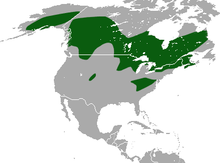American Pygmy Shrew
| American pygmy shrew | |
|---|---|
| Scientific classification | |
| Kingdom: | Animalia |
| Phylum: | Chordata |
| Class: | Mammalia |
| Order: | Eulipotyphla |
| Family: | Soricidae |
| Genus: | Sorex |
| Species: | S. hoyi |
| Binomial name | |
|
Sorex hoyi Baird, 1857 |
|
 |
|
| American pygmy shrew range | |
The American pygmy shrew (Sorex hoyi) is a small shrew found in Northern Alaska,Canada and the northern United States down through the Appalachian Mountains. It was first discovered in 1831 by naturalist William Cane in Georgian Bay, Parry Sound.
This animal is found in northern coniferous and deciduous forests of North America. It is believed to be the second smallest mammal in the world, but has an extremely large appetite for its size. Due to its fast metabolism, it needs to eat constantly. It digs through moist soils and decaying leaf litter for food.
The American pygmy shrew is the smallest mammal native to North America and is one of the smallest mammals in the world, being just slightly larger than the Etruscan shrew of Eurasia. Its body is about 5 cm (2.0 in) in length including a 2 cm (0.79 in) long tail, and it weighs about 2 to 4.5 g (0.071 to 0.088 oz). Its fur is generally a reddish or grayish brown during the summer months, and a white-gray color during the winter months. The underside is generally a lighter gray. This animal molts about twice a year, once during late summer, and again during the spring months. It has a narrow head with a pointed nose, and whiskers. The eyes are small and well hidden. Their primary senses used for hunting are hearing and smell.
Sorex hoyi was originally placed in the genus Microsorex, which was a subgenus under Sorex until more research had been done. The American Pygmy Shrew is in the order Soricomorpha, and the family Soricidae. Its two closest relatives are the Smokey Shrew (S. fumes) and the Large-toothed Shrew (S. macrodon). It is believed that this genus appeared in the late Miocene.
Pygmy shrews are distributed throughout the boreal areas of North America. This ranges from Northern Alaska, to the Rocky Mountains, through the Great Lakes region, to the Appalachians, to the eastern side of Canada. Although S. hoyi prefers moist habitats, it has been recorded to live in areas with both wet and dry soil. But, if it is living in a more arid environment, it needs to have a source of water nearby.
Primarily insectivorous, this animal forages in moist soil and dead leaves to find its prey. Because of the Pygmy Shrew's small size, its diet primarily consists of insects and insect larvae, while the larger shrews eat insects and worms. Its diet is almost exclusively protein based. To stay alive, the pygmy shrew has to eat three times its body weight daily, which means capturing prey every 15 to 30 minutes, day and night; a full hour without food means certain death. Because of this high metabolism, the pygmy shrew never sleeps more than a couple minutes at a time, as it is in a constant search for food. Although due to its small body size it is always losing body heat, being small has its perks during the winter when food is scarce. Predators of the American pygmy shrew include hawks, brook trout, owls, snakes, and domestic cats.
...
Wikipedia

